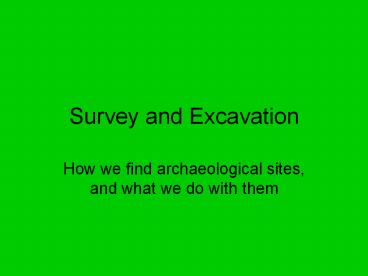Survey and Excavation - PowerPoint PPT Presentation
1 / 20
Title: Survey and Excavation
1
Survey and Excavation
- How we find archaeological sites, and what we do
with them
2
Archaeology as a field discipline
- Need to do it to understand it
- Popular image vs. reality
- Field work vs. laboratory analysis
- Field Schools
- This summer Schoharie Valley field school, SUNY
Albany NYS Museum
3
Archaeological Survey
- Determined by research design
- Sampling
- Cant look/dig everywhere have to sample area
- Sampling bias (some sampling strategies will
differentially find some types of sites and not
others) - Sampling Strategies
- Judgmental (prior knowledge)
- Random (no bias)
- Systematic (patterned bias)
- Haphazard (unknowable bias to be avoided)
- Goals of Survey
- Locate and map archaeological sites on the
landscape - Sample the contents of sites to see if further
investigation is warranted
4
Survey Techniques
- Windshield survey
- Surface survey
- Shovel Test Survey
- Auger survey
- Crop marks
- Satellite Imagery
- Remote Sensing
5
Surface Survey
6
(No Transcript)
7
Remote Sensing
Ground Penetrating Radar
8
Aerial Photography
9
Crop Marks
10
Satellite Images
11
Case StudyRichard MacNeish and the Tehuacan
Valley Survey
- MacNeish major figure in American Archaeology
- Major Question where and how was agriculture
developed in New World? - Farming the most significant development in all
of human history
12
MacNeishs Research Design
- Problem where and when was corn (Zea mays)
domesticated? - Background probably domesticated form of
Teosinte, probably from Southern Mexico - Data Needs preserved early corn in
archaeological context - Methodology Intensive survey of dry caves in
Tehuacan Valley
13
Maize and Teosinte
14
Mexico
15
Results of Survey
- Surveyed 575 square miles identified 450 sites
over 12 cave systems - Radiocarbon dating - extensive chronology over
10,000 years BP - Coxcatlan Cave Site identified corn cobs carbon
dating to 5,000 BC - intermediate between Maize and Teosinte
16
Coxcatlan Cave, Tehuacan Valley
17
Excavation
- Goals
- Recover and record Archaeological Data
- Maintain control of context association
- Provenience 3-dimensional location of
archaeological data - Horizontal vs. Vertical patterning (time vs.
space) - Trade off Area vs. Depth
- Sampling Conservation Ethic
18
(No Transcript)
19
(No Transcript)
20
Context and Association
- Key concepts in identifying archaeological
patterning - Contextlocation and circumstances of
archaeological data - Associationobjects within same context are
associated































